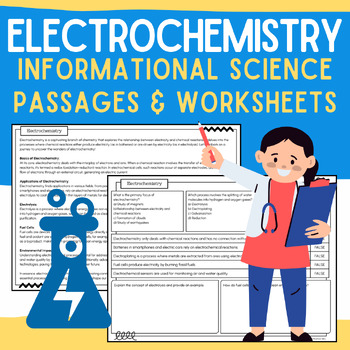Electrochemistry Packet: Informational Passages, Worksheets, & Vocabulary
- PDF
Description
- Multiple informational passages on electrochemistry and its subtopics
- Worksheets with various forms of questions for each informational reading article
- 3 pages of vocabulary for students to write definitions and doodle a picture
- Answer keys included for easy self-assessment
- Bonus SEL & life skills activity for FREE
Electrochemistry is a fascinating branch of chemistry that explores the world of chemical reactions involving electricity and the transfer of electrons. Our resource provides multiple informational passages covering various subtopics in electrochemistry, including electrochemical cells, oxidation-reduction reactions, and more. Each passage is accompanied by worksheets featuring a variety of question formats to reinforce understanding. Additionally, students can expand their vocabulary and creativity with three pages dedicated to writing definitions and doodling pictures related to electrochemistry terms. Answer keys are included for easy self-assessment. As a bonus, we offer a SEL & life skills activity for FREE, providing a well-rounded learning experience.
Similar Resources:
What is Matter?
Properties of Matter
States of Matter
Physical & Chemical Properties
Physical & Chemical Changes
Density & Buoyancy
Solubility Packet
Conductivity
Thermal Conductivity
Atomic Structure
Atomic Theories
Electron Configuration
Subatomic Particles
Atomic Number
Isotopes
Periodic Table
Periodic Trends
Period Table: Metals
Periods Table: Nonmetals
Metalloids
Chemical Bonding
Metallic Bonding
Chemical Equations & Balancing Equations Packet





